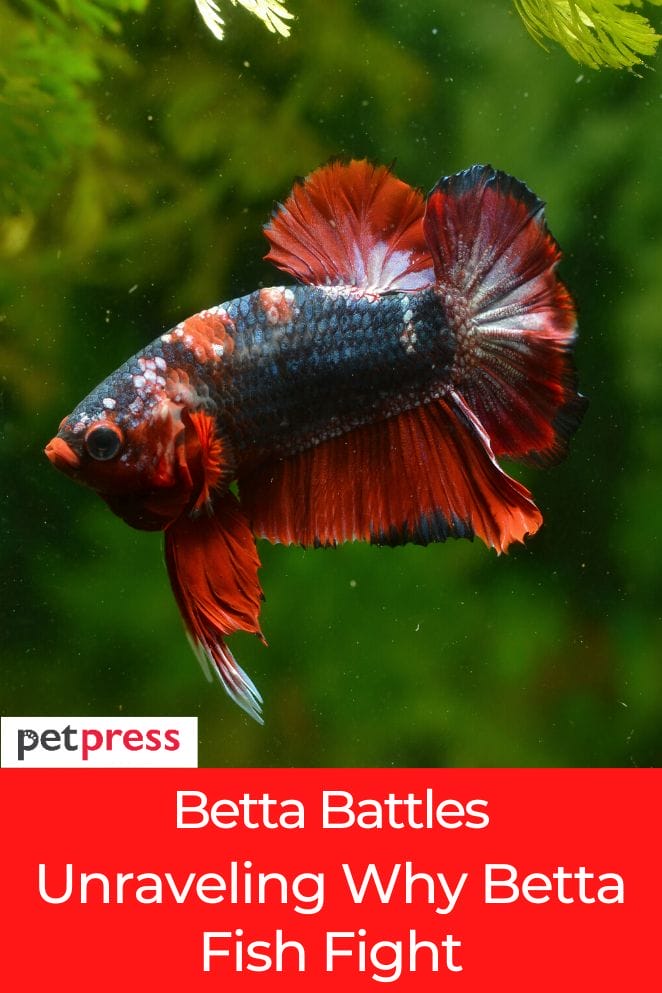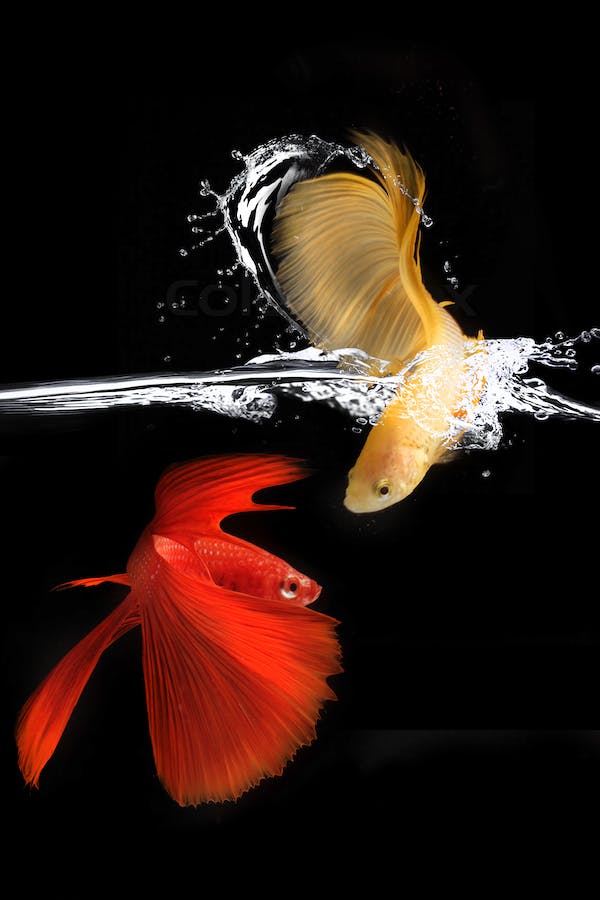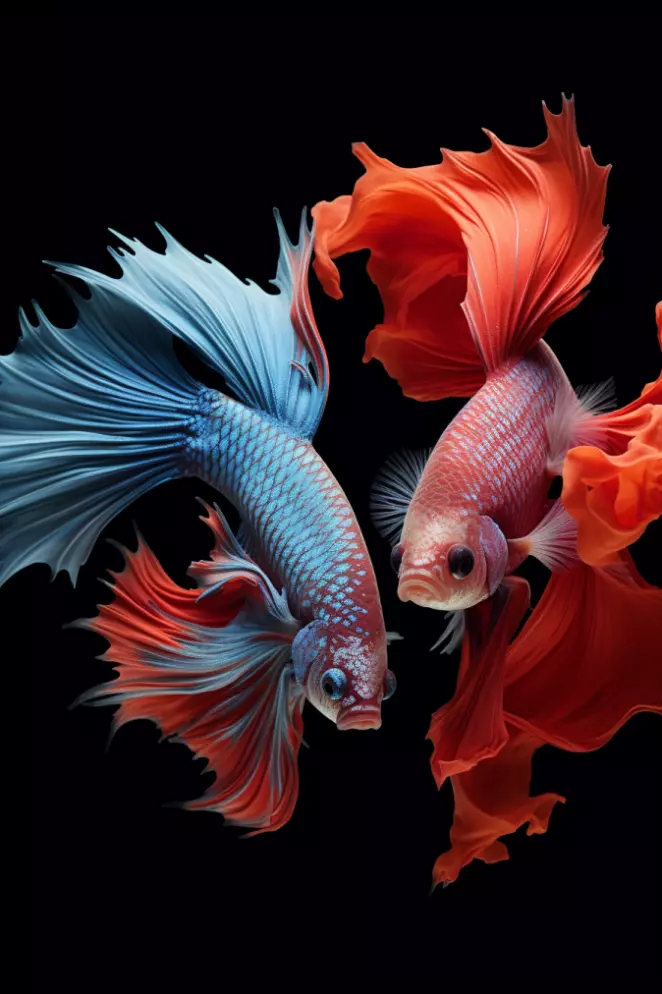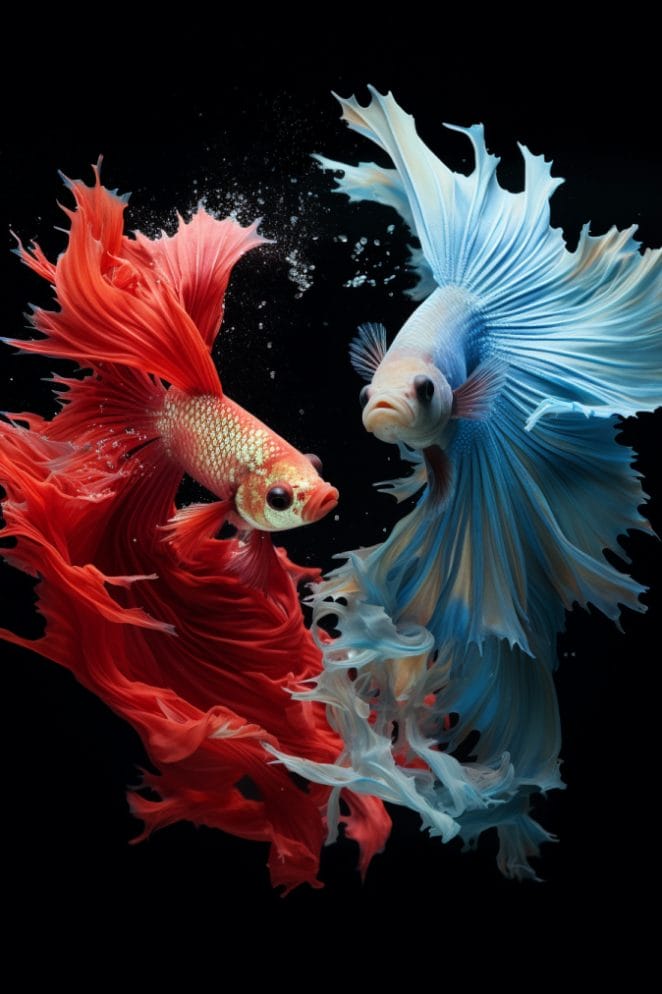
Betta fish, commonly referred to as Siamese fighting fish, have gained popularity due to their striking colors and distinctive appearance.
However, their notoriety also stems from their aggressive nature, often resulting in confrontations.
In this blog post, we’ll delve into the reasons behind Betta fish fights, recognize the signs of such behavior, explore the duration of these skirmishes, and discuss effective measures to prevent and manage them.
What Is Fighting in Betta Fish?
Fighting among Betta fish occurs when two male specimens exhibit aggressive behavior towards each other, frequently leading to physical injury.
This conduct predominantly manifests in male Betta fish due to their innate territorial and competitive instincts.
- Read also: How long do betta fish live
- Read also: Understanding How Do Betta Fish Sleep

Why Do Betta Fish Fight?
Betta fish engage in combat for various reasons, each rooted in their natural instincts and behaviors:
Territoriality
Betta fish are inherently territorial creatures.
In the wild, they stake out territories to claim as their own, which they fiercely defend against intruders.
This territorial behavior remains strong even in captivity, where Betta fish will vigorously protect their space from perceived threats, including other Betta fish.
When another male Betta enters their territory, it triggers a defensive response, often escalating into a fight to assert dominance and maintain control over their territory.
Mating rights
Male Betta fish exhibit aggressive behavior to establish dominance and secure mating rights with females.
In the wild, competition for mates is intense, and only the strongest and most dominant males are successful in attracting females for breeding.
This competitive drive is deeply ingrained in Betta fish, leading them to engage in fights to prove their superiority and gain access to potential mates.
Within the confines of an aquarium, this behavior persists, with male Bettas vying for dominance and the opportunity to reproduce.
Resource competition
Betta fish may also fight over essential resources such as food, shelter, and mates.
In environments where resources are limited or scarce, competition among Betta fish intensifies as individuals strive to obtain the necessary resources for survival and reproduction.
This competition can escalate into aggressive encounters, as Betta fish vie for access to food, desirable hiding spots, and potential mates.

Signs of Fighting in Betta Fish
Detecting signs of fighting in Betta fish is crucial for proactive intervention and maintaining a harmonious aquarium environment.
Here are detailed explanations of common indicators:
Chasing
Aggressive chasing is a prevalent sign of conflict among Betta fish.
When one Betta relentlessly pursues another, it signifies territorial disputes or attempts to establish dominance.
The aggressor may corner the opponent, leading to heightened stress and potential physical harm.
Flaring
Flaring is a visual display of aggression wherein Betta fish extend their gills and fins, making themselves appear larger and more intimidating.
This behavior is a defensive mechanism, employed by both combatants to establish dominance and deter the other.
Flaring is often accompanied by vibrant color displays as the fish attempt to assert their presence and dominance in the face of a perceived threat.
Nipping
Nipping at each other’s fins is a direct form of aggression among Betta fish.
This behavior can result in physical damage, including torn fins and tails.
Nipping is a clear indication of territorial disputes or competition for resources.
In the absence of intervention, it can escalate into full-blown fights, posing a risk to the overall well-being of the fish involved.
Rapid Breathing
Stress-induced rapid breathing is a physiological response that can be observed in Betta fish experiencing fighting-related stress.
The increased respiratory rate is a sign of heightened anxiety and discomfort.
Monitoring changes in breathing patterns is crucial, as prolonged stress can compromise the immune system and make fish more susceptible to diseases.
How Long Does Betta Fish Fight?
The duration of fighting among Betta fish varies, spanning a range from brief skirmishes lasting only a few seconds to more extended confrontations that can persist for several minutes.
The length of these bouts is contingent upon the intensity of the aggression displayed by the involved individuals.
Factors such as the degree of territoriality, the competitiveness of the fish, and the availability of resources contribute to the duration of Betta fish fights.
Observing the dynamics of these interactions can provide insights into the underlying reasons for the aggression and aid in implementing timely interventions to mitigate potential harm and stress among the fish in the aquarium.

How to Stop Fighting
Putting an end to fighting among Betta fish requires thoughtful interventions and adjustments to their environment.
Here are detailed steps to effectively stop aggression:
Provide adequate space
Ensure that each Betta fish has ample space within the tank to establish and defend its territory.
Inadequate space can intensify territorial disputes, leading to increased aggression.
A well-designed aquarium with appropriate hiding spots and defined territories can help minimize confrontations.
Reduce stress
Minimize stress factors that can trigger aggressive behavior among Betta fish.
Overcrowding is a common stressor, so maintain a suitable fish-to-tank ratio.
Ensure optimal water quality by regularly monitoring and maintaining appropriate parameters.
Sudden changes in the environment, such as fluctuations in temperature or lighting, can also induce stress and contribute to fighting.
Stabilizing the aquarium conditions provides a more serene environment for the fish.
Separate the fish
If the fighting persists despite environmental adjustments, consider separating the Betta fish.
This can be achieved by placing them in individual tanks or using tank dividers within a larger tank.
Isolating the aggressive individuals prevents physical harm and allows each Betta to establish its territory without interference.
Keep them separated until signs of aggression diminish, and carefully reintroduce them if desired.
Introduce visual barriers
Adding visual barriers, such as plants or decorations, can help create distinct territories within the tank.
This reduces direct line-of-sight between Betta fish, minimizing aggressive encounters.
Creating a more visually complex environment also promotes exploration and diversion, reducing the likelihood of confrontations.
Monitor and learn
Regularly observe the behavior of Betta fish to detect early signs of aggression.
Understanding their individual temperaments and triggers allows for proactive management.
If certain individuals consistently exhibit aggression, consider permanent separation or rehoming to ensure the well-being of all fish in the aquarium.
- Read also: What Is a Good First Pet Fish?
- Read also: How Can You Tell a Fish is Happy

Conclusion
Combativeness among Betta fish is a frequent occurrence, posing potential harm to the fish involved.
However, by comprehending the underlying causes of fighting and implementing measures to alleviate stress while ensuring sufficient space, one can effectively deter conflicts in a Betta fish tank.
Understanding the root causes of aggression and fostering a conducive environment are key steps toward maintaining harmony among Betta fish in captivity.
FAQs
Betta fish fight due to territoriality, mating rights, and resource competition.
Fighting can last from a few seconds to several minutes, depending on the intensity of the aggression.
Provide adequate space, reduce stress, and separate the fish if necessary.


GIPHY App Key not set. Please check settings